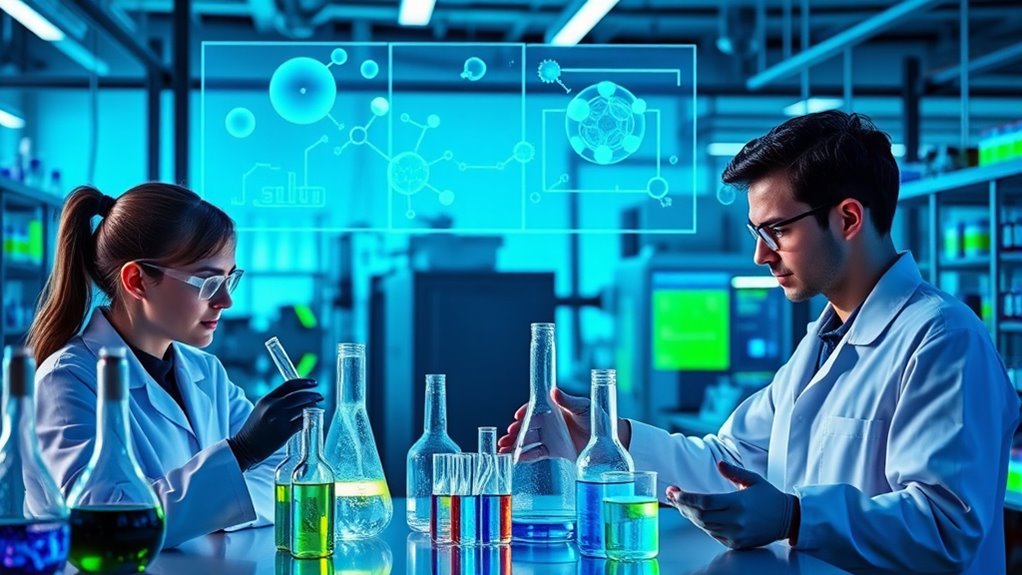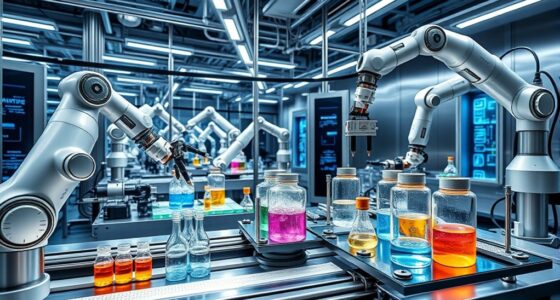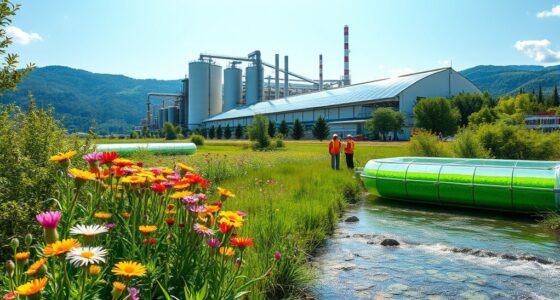In 2025, watch for start-ups pioneering sustainable chemical solutions, like those developing efficient electrocatalysts that use earth-abundant materials, reducing costs and environmental impact. Keep an eye on innovators creating bio-based drop-in chemicals and recycling technologies that support a circular economy. AI-driven process optimization and modular manufacturing startups are transforming how chemicals are produced locally and sustainably. Stay tuned to discover how these trailblazers are shaping the future of the sector.
Key Takeaways
- AI-driven startups like ReactWise are revolutionizing drug manufacturing with digital twins and automation, boosting efficiency up to 30x.
- Companies developing bio-based drop-in chemicals, such as bio-polyurethanes and epoxies, support sustainable, process-compatible replacements for fossil materials.
- Innovators focusing on noble metal-free electrocatalysts and nanostructured materials are advancing green CO₂ reduction and organic transformations.
- Modular, decentralized manufacturing startups like Nium and NitroFix enable localized, low-carbon chemical and fertilizer production.
- Digital automation and blockchain platforms are enhancing safety, transparency, and efficiency in chemical production and recycling sectors.
Pioneers in Electrocatalyst Development for Sustainable Chemical Synthesis
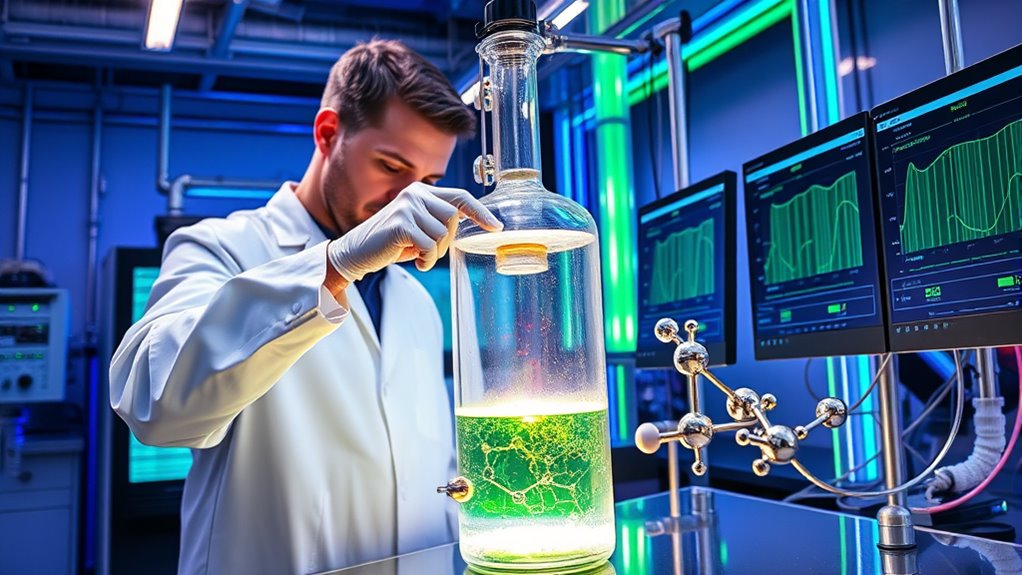
Pioneers in electrocatalyst development are driving a revolution in sustainable chemical synthesis by creating materials that are both cost-effective and environmentally friendly. They focus on developing noble metal-free catalysts, reducing reliance on scarce resources and lowering costs. Carbon-based electrocatalysts are used to enhance CO2 reduction, promoting greener pathways. Nanostructured materials improve catalytic efficiency and selectivity, enabling more precise bond activation. Researchers are also tailoring chemical structures to optimize performance in organic transformations. Increasingly, they incorporate earth-abundant materials to boost scalability and safety. These innovations facilitate the electrochemical fixation of CO2 into valuable chemicals, all under mild conditions that cut energy use. Wheatgrass and other plant-based extracts are being explored as sustainable precursors for catalyst synthesis, further advancing environmentally friendly approaches. Additionally, the integration of dynamic testing methods allows for real-time performance evaluation, accelerating the development of next-generation electrocatalysts.
Innovations in Bio-based Drop-in Chemicals and Recycling Technologies
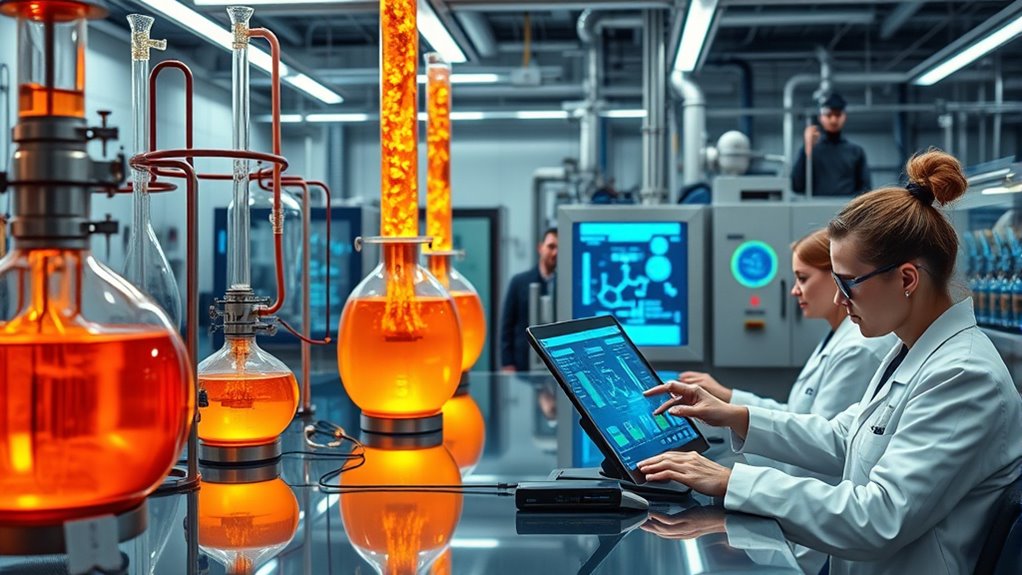
Innovations in bio-based drop-in chemicals and recycling technologies are transforming how industries approach sustainability by enabling the seamless replacement of fossil-based materials without altering existing manufacturing processes. These bio-based drop-ins directly substitute fossil chemicals, supporting the EU Bioeconomy Strategy and Zero Pollution Action Plan by reducing carbon footprints and pollutants.
They allow industries to switch to greener inputs using existing infrastructure, lowering capital costs compared to building new biorefineries. Advances in bio-based polyurethanes and epoxy resins provide safer, renewable alternatives that match performance standards, easing adoption. Incorporating market trends and emerging innovations helps companies stay ahead in the shifting landscape of sustainable materials. Additionally, ongoing research into Vetted – Halloween Product Reviews demonstrates the importance of rigorous testing and validation to ensure new bio-based products meet industry standards and consumer expectations.
Integrating these chemicals into circular bioeconomy models enhances resource efficiency by valorizing biomass waste and collaborating with recycling firms. Supported by favorable regulations and funding, these innovations accelerate industry shifts toward sustainable, low-impact materials without compromising process compatibility or product quality. Additionally, juice cleansing practices exemplify how optimizing resource use and reducing waste can contribute to broader sustainability goals.
AI-Driven Process Optimization and Digital Automation Start-ups

AI-driven process optimization and digital automation are transforming chemical manufacturing by enhancing efficiency, accuracy, and safety. Start-ups like ReactWise use AI to accelerate drug manufacturing processes up to 30 times faster, supported by Y Combinator.
These technologies enable real-time monitoring through digital twin tech, predictive maintenance, and automation of repetitive tasks via robotic process automation (RPA). Predictive analytics help you forecast outcomes, while AI-driven quality control guarantees compliance and reduces defects. Incorporating home organization principles can further streamline workflows and reduce clutter in manufacturing environments, contributing to improved operational efficiency. Implementing essential oils for health and safety can also support worker well-being in manufacturing settings, reducing stress and promoting a healthier work environment. Additionally, integrating data management systems ensures data accuracy and security throughout production processes.
Digital automation streamlines supply chains, optimizes energy use, and improves workplace safety by detecting hazards early. As the AI sector grows at a CAGR of nearly 29%, these innovations offer significant competitive advantages, lower costs, and open new growth opportunities.
Expect AI-powered automation to become integral to the future of chemical manufacturing.
Breakthroughs in Chiral Materials for Electronics and Quantum Applications
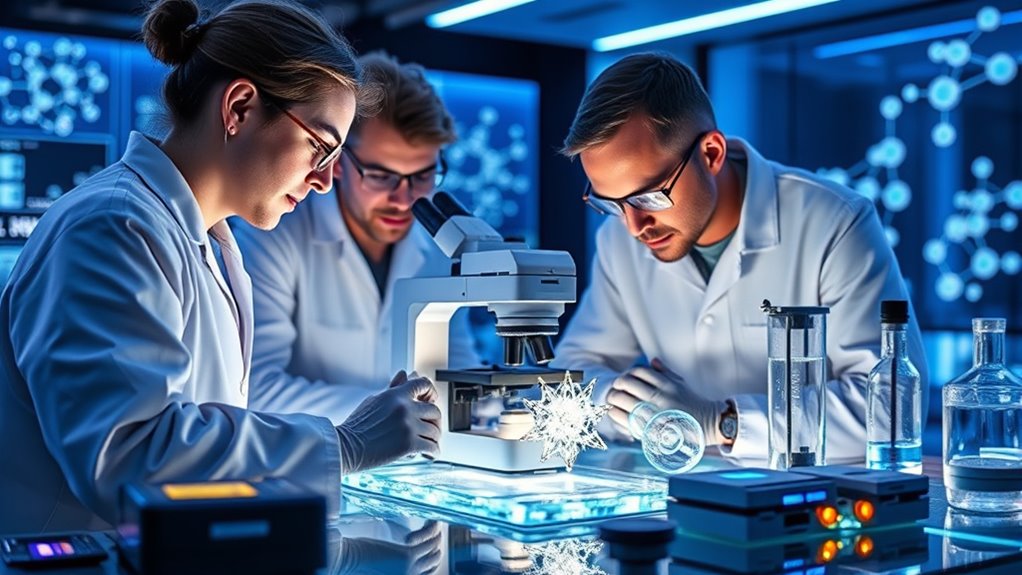
Advancements in chiral materials are revealing new possibilities for electronics and quantum technologies. You can now leverage chirality to control spin-dependent electronic transport, boosting spintronics and quantum computing. Backyard greenhouses, though seemingly unrelated, demonstrate how innovative design and sustainable practices can revolutionize traditional approaches. Research at CCNY shows that MnSb₂Te₄’s tunable chirality allows modulation of topological band structures through light element doping, expanding platforms for exploring quantum phases. Tunable chiral topological magnets could enable dissipationless current flow via the Quantum Anomalous Hall effect, promising energy-efficient devices. Tools like neutron beam manipulation at NIST improve chirality characterization, accelerating research. Collaborations, such as those at the Harlem Center for Quantum Materials, focus on creating functional chiral materials with essential tech applications. These breakthroughs are paving the way for next-generation quantum electronics with enhanced performance and sustainability.
Circular Economy Initiatives and Material Reuse Ventures
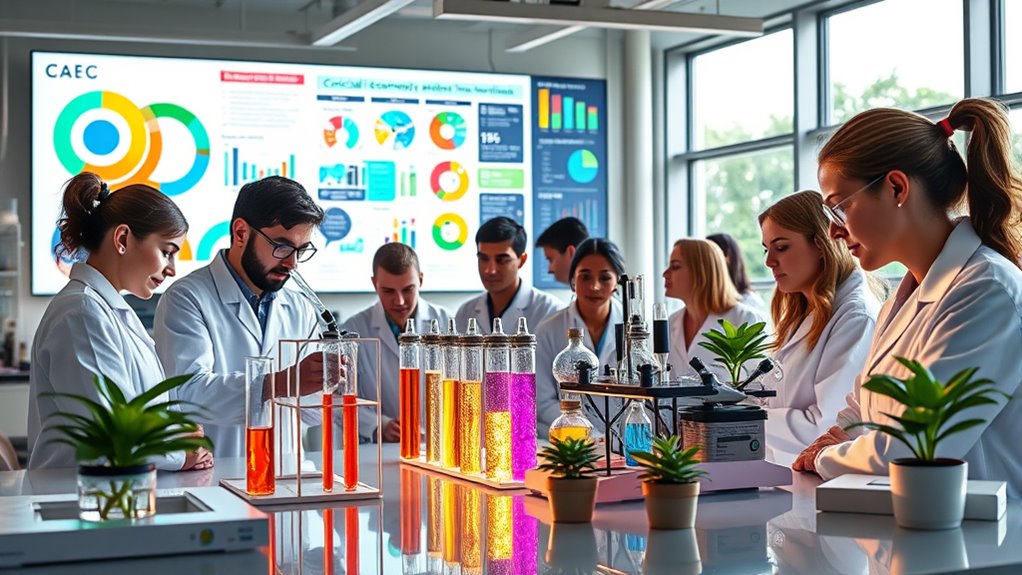
As the push for sustainability accelerates, startups are leading the way in circular economy initiatives by developing technologies that reuse and transform materials. You’ll find companies focusing on chemical recycling, converting waste into valuable chemicals with advanced catalysts that boost efficiency.
These startups often develop solutions compatible with existing industrial infrastructure, making adoption smoother. Platforms like Circularr use blockchain to reward plastic recycling, ensuring transparency and traceability, while offering tradable tokens like $CIRP to incentivize participation.
Others, like Loop CO2 and Arrakis Materials, turn CO2 into upcyclable plastics and carbon-negative minerals, providing sustainable alternatives for industrial use.
Major industry players are partnering with these startups through initiatives like the CIRCULAR program, fostering innovation and expanding material reuse across sectors.
Low-Carbon Feedstock Solutions From Renewable Resources
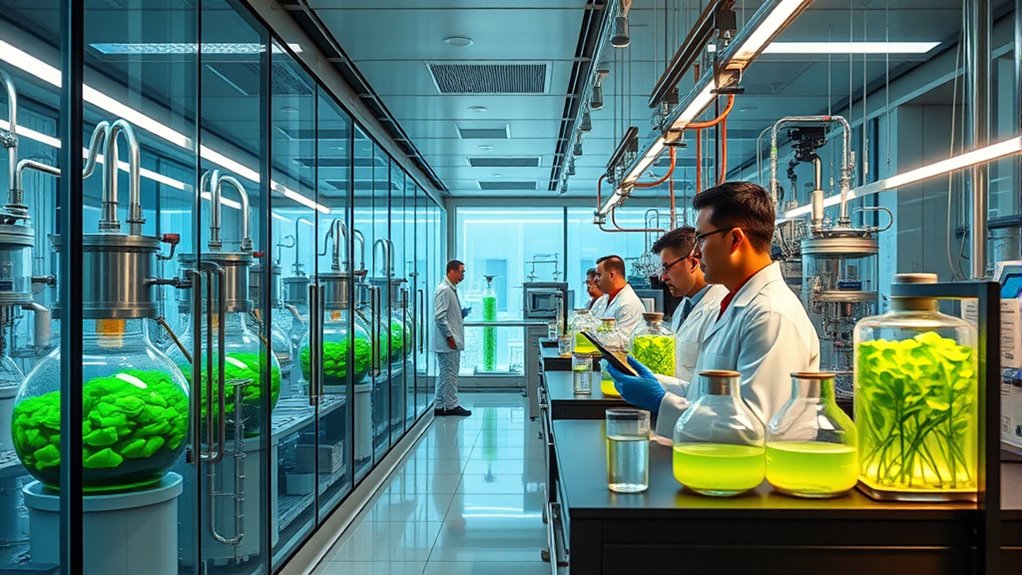
Low-carbon feedstock solutions from renewable resources are transforming the chemical industry by offering sustainable alternatives to traditional fossil fuels. Bio-based feedstocks like soybean oil, beef tallow, and palm oil provide renewable raw materials for producing renewable diesel, reducing lifecycle greenhouse gas emissions by up to 85%.
Many existing refineries can adapt to these feedstocks without major infrastructure changes, making adoption easier. Technologies like HydroFlex allow for flexible hydro-treating of various renewable sources to produce diesel and jet fuels.
Forest waste biomass is also a valuable, abundant resource, supporting bioenergy production and forest management. Additionally, converting end-of-life plastics into fuel feedstocks and recycling scrap steel help reduce waste and emissions.
These solutions are gaining traction, driven by policies like California’s Low Carbon Fuel Standard.
Modular and Decentralized Chemical Manufacturing Start-ups

Modular and decentralized chemical manufacturing startups are reshaping how chemicals are produced by enabling flexible, location-specific operations. These units are designed to be capital-light and multi-use, allowing deployment at various sites and reducing reliance on large centralized plants.
By producing closer to end-users, you can cut transport emissions and improve supply chain resilience. Modular units leverage economies of number, making mass production cost-effective, and emphasize easy installation over complex infrastructure.
Startups like Nium, NitroFix, Nitricity, and Ammobia focus on localized ammonia and fertilizer production, aiming for sustainability and lower carbon footprints. Technological innovations—digitalization, AI, IoT, and blockchain—enhance automation, safety, and efficiency.
This approach supports regional economies, decreases environmental impact, and offers scalable solutions, though overcoming cost and regulatory challenges remains essential for widespread adoption.
Frequently Asked Questions
How Are Start-Ups Overcoming Scalability Challenges in Electrocatalyst Deployment?
You can overcome scalability challenges in electrocatalyst deployment by focusing on using advanced, high-performance materials and adopting modular designs that easily scale. Incorporate automation for precision, collaborate on research to improve efficiency, and standardize processes to guarantee consistency.
To reduce costs, develop alternative catalysts, achieve economies of scale, and implement recycling programs.
Address technical issues through pilot testing, advanced diagnostics, and flow optimization, ensuring smooth large-scale deployment.
What Regulatory Hurdles Do Bio-Based Chemical Innovations Face Globally?
Imagine steering a maze of towering regulatory walls, each region crafting its own unique gates. You face lengthy, costly approval processes that slow your bio-based innovations’ entry into the market.
Strict scrutiny, safety, and environmental standards demand constant adaptation. With inconsistent policies and complex infrastructure demands, you struggle to keep pace.
Overcoming these hurdles requires harmonized regulations, streamlined certifications, and global cooperation to open your sustainable chemicals’ full potential.
How Do AI Startups Ensure Data Security in Process Automation?
You guarantee data security in process automation by leveraging AI-driven security platforms that seamlessly integrate with your existing systems. They use advanced techniques like encryption, anonymization, and identity protection to safeguard sensitive information.
Continuous monitoring detects anomalies and insider threats early.
Automating routine security tasks reduces human error and speeds up responses, helping you stay compliant and protect your data effectively in a rapidly evolving threat landscape.
What Are the Key Material Properties Enabling Quantum Applications of Chiral Materials?
You should focus on the material properties that enable quantum applications of chiral materials. Atomic-scale asymmetry is key, creating directional electron flow and spin selectivity.
Strong spin-orbit coupling and broken symmetry boost quantum coherence at room temperature.
Surface states and interfaces enhance electron-photon interactions.
Ligand-induced chirality and self-assembled nanostructures amplify optical responses, making these materials ideal for quantum sensing, spintronics, and bioimaging applications, ultimately advancing scalable quantum technologies.
How Do Circular Economy Startups Establish Supply Chain Collaborations for Recycling?
You establish supply chain collaborations for recycling by aligning value chains and forming industry partnerships. You leverage NGOs, coalitions, and government programs to bridge gaps and foster trust.
Incorporating feedback from downstream users helps improve processes. Using innovative tech like blockchain guarantees transparency and traceability.
You focus on designing recyclable materials, reducing waste, and promoting resource reuse. These efforts create sustainable, closed-loop systems, ensuring long-term success and economic viability in your circular economy initiatives.
Conclusion
As you watch these startups forge ahead, it’s clear they’re lighting the way like stars guiding a ship through uncharted waters. Their innovations in sustainable chemistry, digital automation, and circular economy efforts aren’t just sparks—they’re igniting a brighter, greener future. Stay tuned, because these pioneers are shaping a sector where progress flows as freely as a well-crafted catalyst, transforming challenges into opportunities and steering us toward a more sustainable world.
